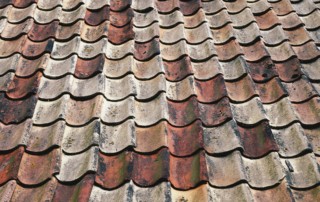If you are a homeowner in the Venice and Sarasota area, you may be concerned about how sunlight affects your roof. You may be worried about how hurricane-force winds may damage your roof. You may even have to reinforce your roof to keep out the pests and critters who would like nothing better than setting up residence on your roof or in your attic. But you may not be thinking about another concern which can appear in this area – preventing roof algae and moss from accumulating over the years.
Can Roof Algae Cause a Problem? Typically, roof algae is usually more of an eyesore than a problem – at least in the short term. It can make your roof look older and distract from the beauty of your home. Therefore removing it is especially important for those selling a home, in deed restricted communities – or simply wanting to keep their home looking its best. But over time, algae (as well as moss, mold and mildew) can wreak havoc on your roof.
Algae is actually quite common in this region. Although it is not a problem initially, if left unchecked it can cause your roofing materials to rot over the years. Algae thrives in shady, moist areas. Therefore the most likely place you will find roof algae is on shingles which do not receive direct sunlight for much of the day, such as under large trees.
One of the most important aspects of a healthy roof is that it can shed water and moisture which can erode the roofing tiles or shingles. Roof algae naturally retains a fair amount of moisture, and the damp conditions can degrade your roof’s integrity and even cause shingles to rot and deteriorate. The humid climate in Florida just adds to the damp environment which may exist, not permitting tiles with algae to ever really dry out.
Did You Know? Your roof can “catch” roof algae and moss from your neighbor’s home. Spores are often picked up in the wind and carried to your roof, where they settle in and begin to grow.
When looking for algae growth, be sure to check your gutter system (including downspouts). Look for dark areas which may be a bit oily or slimy.
Although you may be ok with the dark spots on your roof, the materials may be suffering underneath. While you may not notice a change on the surface of the roof, a leak could be developing underneath. If you do not want to get on the roof to look for algae (or other conditions which may be encouraging leaks), you can check the underside of the roof. If possible to climb into the attic, look around for telltale dark spots of algae which may be growing in the dark, moist areas of a hot and humid attic. Algae requires moisture, so if it is growing on your roof framing or in the eaves, you may very well have a leak.
Ridding Your Roof of Algae
There are some proactive measures you can take to avoid algae, such as trimming your trees to let the sun shine on your roof, and checking your roof and gutters often for any signs of growth before it gets out of control. But the best way to make sure your roof algae never gets past the “just ugly” stage is by having your roof cleaned during its annual inspection. These yearly checkups by a professional roofing company are the best way to ensure that your roof will enjoy the longest life possible, and save you money down the road.
Call [company_name] today to schedule your inspection, and guarantee that your roof is in top condition.




